When to Wear Compression Socks During Pregnancy
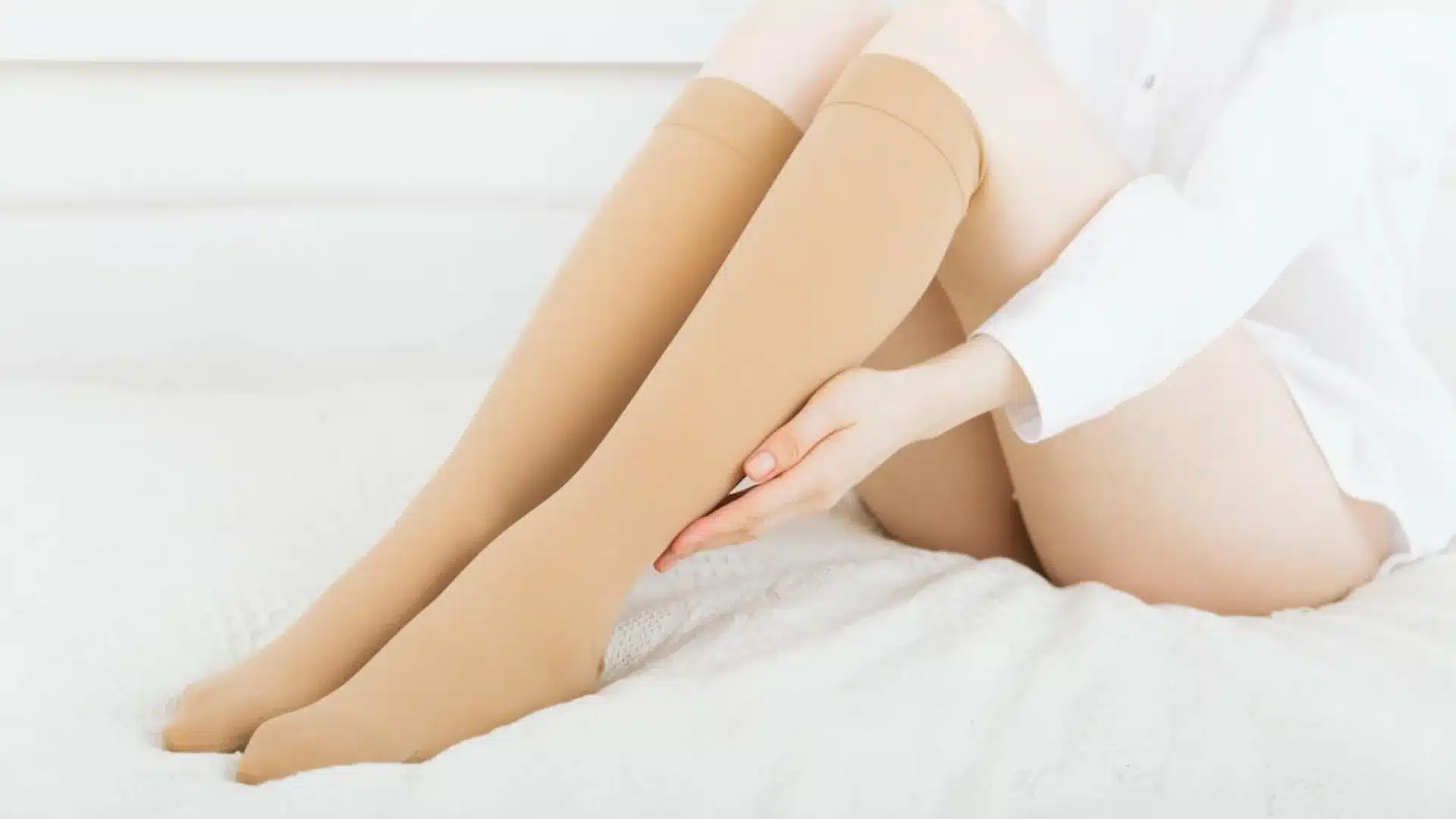
Pregnancy changes how your legs feel, often sooner than you expect. By midday, they might already feel sore or swollen. Your ankles may feel tighter than they did this morning, and your calves heavier. These changes are common, even if they take you by surprise.
Your body is doing a lot. As your blood volume increases and your growing belly puts extra pressure on your veins, it’s normal for your legs to feel the difference.
One gentle way to feel better? Compression socks. That’s exactly what this mama talk is all about. Let’s walk you through how they work and why they might just become your new favorite pair.
Key Takeaways
- Compression socks gently support circulation and help reduce swelling in your legs and feet.
- Many moms start wearing them in the first or second trimester when heaviness or discomfort begins.
- They can be especially helpful during work, travel, or long periods of sitting or standing.
- Most moms do well with knee-high socks in the 15–20 mmHg range.
- Choose breathable, stretchy material and make sure the fit is snug but not tight.
What Are Compression Socks?
As your pregnancy moves forward, your body begins to produce much more blood and hold onto extra fluids to support your growing baby. On average, blood volume rises by about 45%, though this can vary widely from 20 to even 100 percent by the third trimester.
This increase, along with hormonal changes and added pressure from the uterus, can slow circulation, especially in the lower body.
Compression socks are designed to gently hug your legs and ankles. This light, even pressure helps promote upward blood toward your heart. During pregnancy, when your body is working harder to move fluids, this can make a noticeable difference.
How Compression Socks Can Help in Pregnancy?
Here’s how compression socks can offer real relief during pregnancy:
- Reduces swelling: Helps move built-up fluid so your feet and ankles feel less puffy, especially later in the day.
- Supports healthy circulation: Encourages blood to flow upward, which can feel more challenging as your belly grows.
- Eases leg cramps: Improves circulation to help calm those sudden, uncomfortable cramps, especially at night.
- Prevents varicose veins: Reduces pressure in your legs, which may lower the chance of visible, swollen veins.
- Relieves heaviness and fatigue: Gives your legs a light lift during long hours of sitting or standing so they don’t feel quite so tired by the end of the day.
- May ease nausea: Some research suggests that gentle compression in early pregnancy may also help with symptoms like nausea, vomiting, and lightheadedness by supporting overall circulation.
When Should You Start Wearing Compression Socks During Pregnancy?
You don’t have to wait for discomfort to begin. Compression socks can be helpful at any stage of pregnancy, especially as your body begins to retain more fluids and your circulation slows down.
Here are some moments when they can offer real relief:
- During Travel: Whether you’re flying or on a long road trip, sitting for extended periods can slow circulation and increase the risk of swelling or even blood clots.Wearing compression socks during travel can support healthy blood flow and reduce your risk of Deep Vein Thrombosis (DVT), a condition where blood clots form in deep veins, usually in the legs.
- At Work: If your job involves sitting at a desk for hours or standing on your feet all day, compression socks can help prevent fluid buildup and keep your legs from feeling heavy or achy by the end of your shift.
- While Exercising: Gentle movement is good for circulation and overall well-being during pregnancy. Compression socks can support your legs during prenatal yoga, walking, or any light workout that your doctor approves.
- Daily: Many moms-to-be find it helpful to wear compression socks regularly, especially in the second and third trimesters. It’s a simple way to ease common pregnancy discomforts and support your body as it works hard.
How to Choose the Right Compression Socks
With so many options available, choosing a pair can feel overwhelming. Here’s what to keep in mind:
- Understand Compression Levels: Compression socks are measured in mmHg (millimeters of mercury), a unit that indicates pressure strength. Common levels include:
- 8-15 mmHg
- 15-20 mmHg
- 20-30 mmHg
- 30-40 mmHg
Always check the label before buying, and if you’re unsure, consult your doctor.
- Focus on Fit and Comfort: Socks should feel snug but not restrictive. If they dig in or leave deep marks, they may be too tight. Look for soft fabrics and wide cuffs that stay in place comfortably.
- Choose a Style That Suits: Compression socks come in various lengths, knee-high, thigh-high, and full-length tights. Knee-highs are typically easier to wear and target the lower legs.
- Prioritize Breathable, Gentle Fabrics: Opt for lightweight, moisture-wicking materials that are kind to sensitive skin. Seamless finishes can help prevent irritation.
- Don’t Compromise on Quality: A well-made pair offers consistent compression and better durability. It’s worth investing in socks that feel good and last longer.
Mama Tip: Try buying just one pair to start. See how it feels before investing in a whole set. What works for one body may not feel right for another.
Simple Ways to Style Compression Socks
Compression socks don’t have to clash with your everyday outfits. With a few smart choices, you can stay comfortable and supported without compromising your style. Here are some easy ways to wear them:
1. Under Maternity Dresses
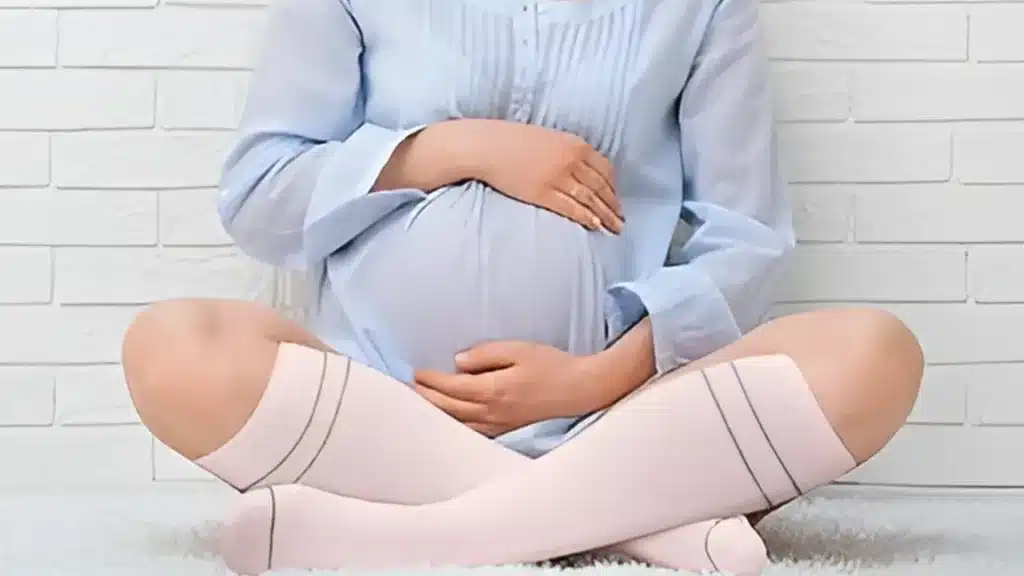
Knee-length or midi dresses help keep your socks hidden while offering plenty of room for movement. Neutral-tone compression socks pair well with most outfits and won’t show through light fabrics.
2. With Leggings or Joggers
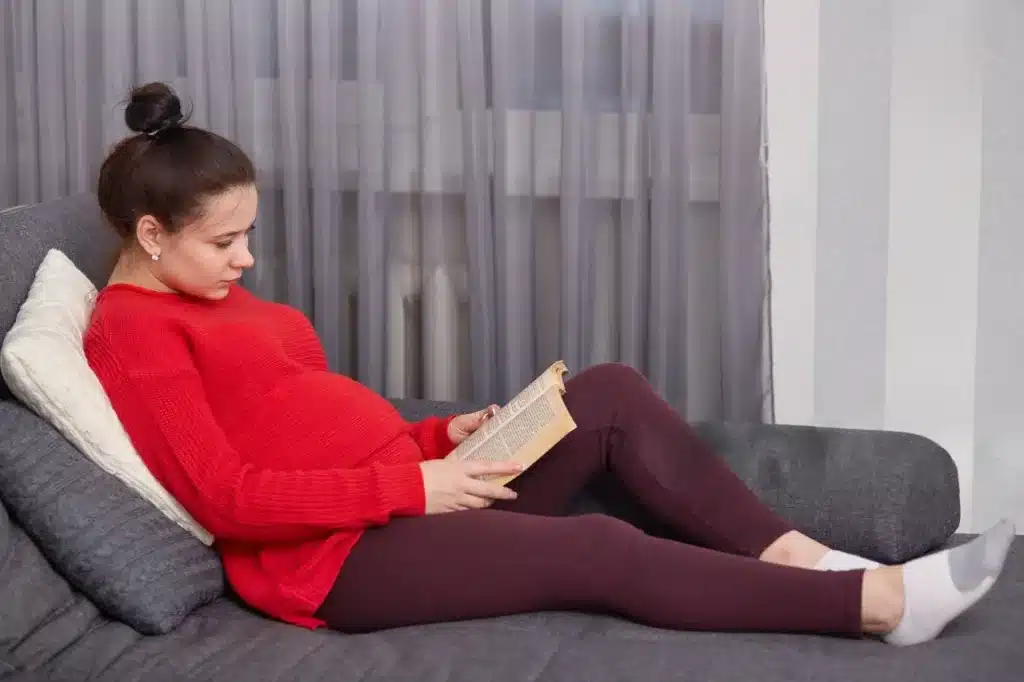
Layer them under soft, stretchy bottoms for a look that’s both practical and cozy, ideal for running errands, light walks, or prenatal yoga. Look for moisture-wicking fabric if you’re planning to stay active.
3. Add a Subtle Pop of Color or Texture
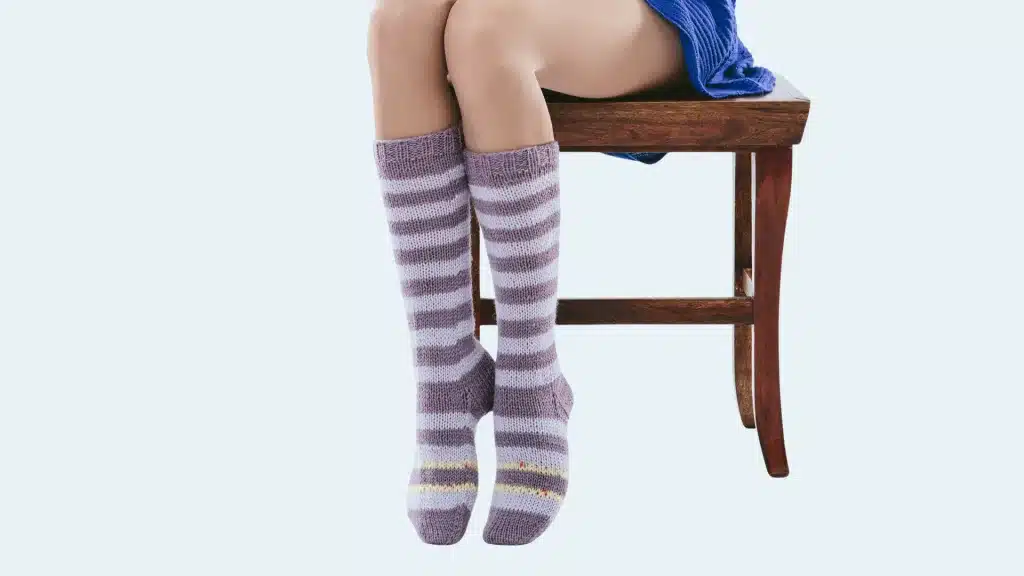
Compression socks now come in a wide range of patterns and shades. Choose a muted stripe or a soft pastel to elevate simple outfits without drawing too much attention.
4. With Travel Outfits
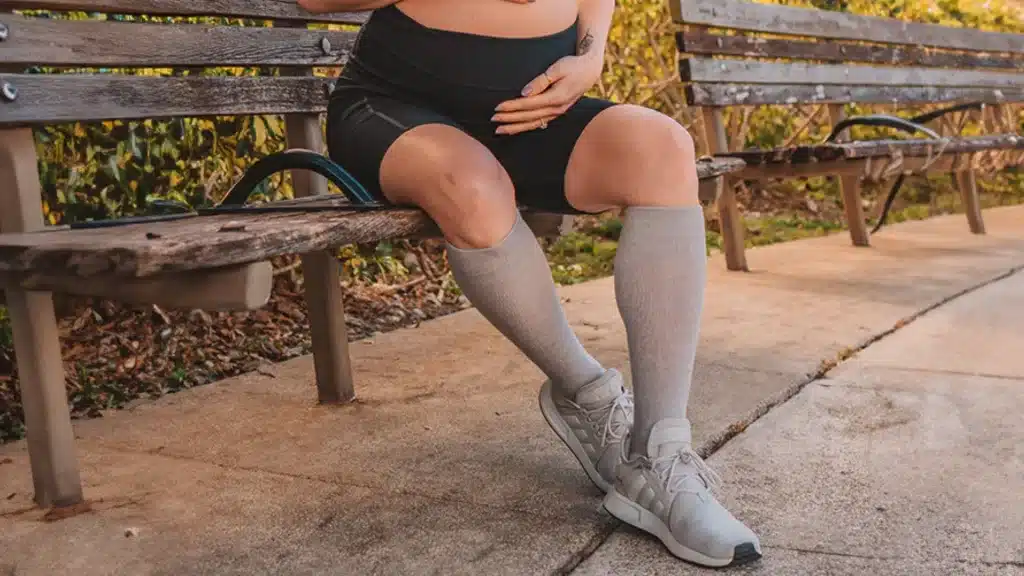
Pair with sneakers, a loose tunic, or a hoodie dress for long car rides or flights. You’ll reduce swelling and discomfort while keeping things casual and comfortable.
5. Layered Under Cold-Weather Looks
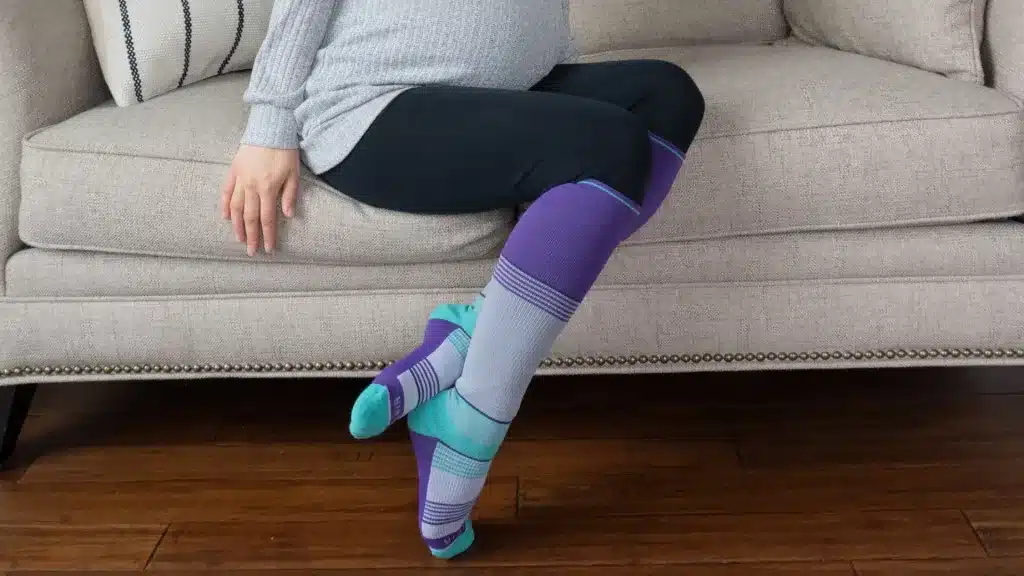
Slip them under tights, long skirts, or maternity jeans during colder months. They’ll keep your legs warm while still doing their job to boost circulation.
What to Keep in Mind
Compression socks are a simple, helpful tool during pregnancy, but wearing them right matters. Here are a few things to keep in mind to stay comfortable and safe:
Do:
- Put them on in the morning, before swelling begins
- Rotate pairs so the fabric stays snug and supportive
- Wash after each wear to keep elasticity and hygiene
Don’t:
- Do not wear them overnight unless your doctor specifically recommends it.
- Avoid socks that feel too tight, as tingling, numbness, or discomfort is a sign they’re not right for you.
- Don’t skip checking with your OB or midwife if you have any circulation concerns, high blood pressure, or diabetes.
Pregnancy changes how your body feels day to day, so if something doesn’t feel right, trust that instinct.
Final Words
Your body is doing a lot right now, and even small shifts in comfort can make a big difference. Compression socks are a reminder to slow down, put your feet up when you can, and care for yourself in the little ways that count.
You deserve to feel good in your body, even on the long days. Let comfort be part of your routine. You’ve got this.
Frequently Asked Questions (FAQs)
1. Can I wear compression socks during my entire pregnancy?
Yes, if they’re comfortable and approved by your provider. Many moms find them helpful from the first trimester through postpartum, especially on days when swelling or leg fatigue is more noticeable.
2. Are compression socks safe to wear in the summer?
Absolutely. Look for breathable, moisture-wicking fabrics designed for warmer weather. Some brands make maternity-specific options that stay cool even during hot months.
3. Do I need a prescription for compression socks during pregnancy?
Not always. Most moms do well with over-the-counter options (15–20 mmHg). But if you have a medical condition like varicose veins or blood pressure concerns, your provider might suggest a higher grade.
4. How long should I wear compression socks each day?
You can wear them throughout the day, from morning until evening, but it’s best to take them off at night unless your doctor advises otherwise.
5. Can compression socks help after delivery, too?
Yes, especially if you’re recovering from a C-section, managing postpartum swelling, or spending long periods sitting or lying down. They can support circulation and reduce the risk of blood clots during recovery.










